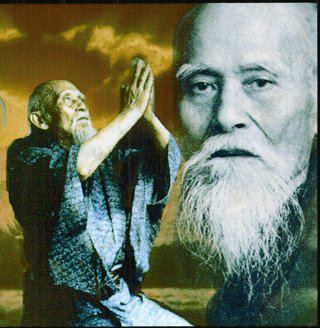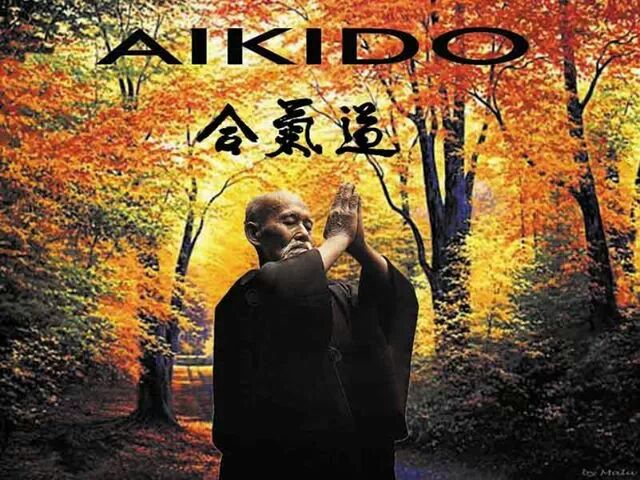Are You Studying Japanese Culture, and Japan as Part
of Your Aikido Research?

Learning about Japanese culture, and Japan is an excellent way of developing your understanding of the martial art of Aikido.
Japan has evolved greatly from the historic past to the modern present, which combines many influences from Asia, Europe and North America.
The Japanese language, written in a combination of three scripts... hiragana came from the Chinese cursive script, katakana, came from a shorthand of Chinese characters, and kanji, imported from China.
Painting has been an art in Japan for ages. The brush is a traditional writing tool, which naturally extended to be used as an artist's tool.
Native Japanese painting techniques are still in use today, as well as techniques adopted from continental Asia and from the West.
The flowing, brush-drawn Japanese language comes from complex calligraphy. Calligraphic art is often too esoteric for Western audiences and general exposure is limited.
However in East Asian countries, the rendering of text itself is seen as a traditional art-form as well as a means of conveying written information.
The written work is made up of phrases, poems, stories, or single characters. The style and format of the writing can copy the subject matter, even the texture and stroke speed.
It can take over a hundred attempts to produce the desired effect of a single character but the process of creating the work is considered as much an art as the end product itself.
Traditional Japanese sculptures were of Buddhist images. The oldest sculpture in Japan is a wooden statue of Amitabha at the Zenko-ji temple. In the Nara period, Buddhist statues were made by the national government, which can be seen in Nara and Kyoto.
Wood has traditionally been used as the chief material in Japan, along with the traditional Japanese architectures. Statues are often lacquered, gilded, or brightly painted. Bronze, other metals, stone and pottery, have all had important roles in Japanese culture.
Ikebana is the Japanese art of flower arrangement. It has gained fame for its focus on harmony, colour use, rhythm, and simple design. It is an art that focuses on expressing the seasons, and is meant to act as a symbol to something greater than the flower itself.
Today Ikebana is practiced widely in Japan, and around the world.
The 4 traditional theatres from Japan are noh, kyogen, kabuki and bunraku. Noh had its origins in music and dance, characterised by masks, costumes, fans and stylized gestures.
The kyogen, of humorous character, had older origin, in 8th century entertainment brought from China, developing itself in sarugaku. In kyogen masks are rarely used and even if the plays can be associated with the ones of noh, currently many are not.
Kabuki appears in the beginning of the Edo period from the dances and representations of Izumo no Okuni in Kyoto.
Due to prostitution of actresses of kabuki the participation of women in the plays was forbidden by the government in 1629 and the feminine characters had passed to be represented only by men (onnagata).
Another characteristic of kabuki is the use of makeup for the actors in historical plays (kumadori).
Japanese puppet theater bunraku developed in the same period as that of kabuki in a competition and contribution relation involving actors and authors. The origin of bunraku is older, it lies back in the Heian period of Japanese culture.
Japanese architecture has a long history like other aspect of Japanese culture. Originally, it was heavily influenced by Chinese architecture, but also develops many differences and aspects similar to India.
Examples of traditional architecture are seen at Temples, Shinto shrines and castles in Kyoto, and Nara. Some of these buildings are constructed with traditional gardens, which are influenced by Zen ideas.
Garden architecture is as important as building architecture and very much influenced by the same historical and religious background. In Japanese culture the garden has the same status as a work of art.
Traditional Japanese clothing distinguishes Japan from all other countries around the world. The Japanese word kimono are the traditional garments of Japan, which come in a variety of colors, styles, and sizes. Men mainly wear darker colours, while women tend to wear brighter colors and pastels.
Most Japanese men only wear the kimono at home or in a very laid back environment, however it is acceptable for a man to wear the kimono when he is entertaining guests in his home.
For a more formal event, Japanese might wear haori and hakama, a half coat and divided skirt. The hakama is tied at the waist, over the kimono and ends near the ankle. Hakama are now for men and women too.
Happi is another type of traditional clothing, but it is not famous worldwide like the kimono. A happi (or happy coat) is a straight sleeved coat that is typically imprinted with the family crest, and was a common coat for firefighters to wear.
Japan also has very different footwear. Tabi, an ankle high sock, is often worn with the kimono. Tabi are designed to be worn with geta a type of thonged footwear. Geta are sandals mounted on wooden blocks held to the foot by a piece of fabric that slides between the toes.
The Japanese culture have a very sophisticated and refined cuisine. In recent years, Japanese food has become fashionable and popular in the USA, Europe and other areas.
Dishes such as sushi, tempura, and teriyaki are some of the foods that are commonly known. The healthy Japanese diet is often believed to be related to the longevity of Japanese people.
Aikido Success Blueprint offers you key action steps for Fast Results!
Japanese Culture,
Aikido and Martial Arts

In the feudal period governed by the samurai class, methods used to train warriors were developed into martial arts, in modern
times referred to collectively as Koryu.
For example... Kenjutsu, Kyudo, Sojutsu, Jujutsu and Sumo, all of which were established in the Edo period of Japanese culture.
Morihei Ueshiba O'Sensei developed the martial art of Aikido from his combat studies of Daito-ryu Aikijujutsu with Sokaku Takeda, and his spiritual studies with the Omoto Kyo and Onisaburi Deguchi.
Japanese culture had a quick social change in the Meiji Restoration, where some martial arts changed to modern sports. Judo was developed by Jigoro Kano, who studied sects of Jujutsu. These sports are still widely practiced in present day Japan and other countries.
Baseball, football, and other popular western sports were imported to Japan in the Meiji period. These sports are commonly practiced in schools along with traditional martial arts.
The most popular professional sports in today's Japan are Sumo, baseball and football. Also many semi-professional organizations, like volleyball, basketball and rugby union, are sponsored by private companies.
Popular Japanese culture reflects the attitudes and concerns of the present but also provides a link to the past. Films, television programs, manga, and music all developed from older artistic and literary traditions, and many of their styles can be traced to traditional art forms.
Contemporary forms of popular Japanese culture, much like the traditional forms, provide not only entertainment but also an escape for the contemporary Japanese from the problems of an industrial world.
Many anime and manga are becoming very popular around the world, as well as Japanese video games, music, fashion, and game shows. Japan is an 'entertainment superpower'.
In the late 1980s, the family was the focus of leisure activities, such as excursions to parks or shopping districts. Although Japan is often thought of as a hard-working society with little time for leisure, the Japanese seek entertainment wherever they can.
A wide variety of popular entertainment are available... music, films, and the products of a huge comic book industry, game centers, bowling alleys, and karaoke are popular hangout places for teens while older people may play shogi or go in specialized parlors.
Together, the publishing, film/video, music/audio, and game industries in Japan make up the growing Japanese content industry, which, in 2006, was estimated to be worth close to 14 trillion Yen ($120 billion.) More on Japanese Culture
Aikido Success Blueprint offers you key action steps for Fast Results!
Has this page been useful to YOU? It may benefit other people too! Please go ahead and pass it on - Share via the Link Bar below - many thanks!
Sick of the Elite Control System? Unplug from the Matrix Now!
We Are The Shield a national volunteer powered movement, working across the UK to prevent harm before it happens. Street patrols, trained volunteers, and community support for vulnerable woman and children - Click to Get Involved!







